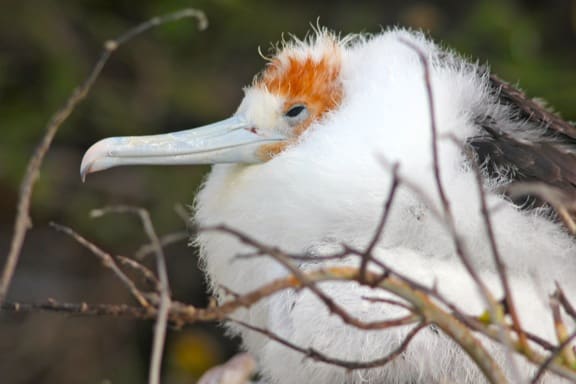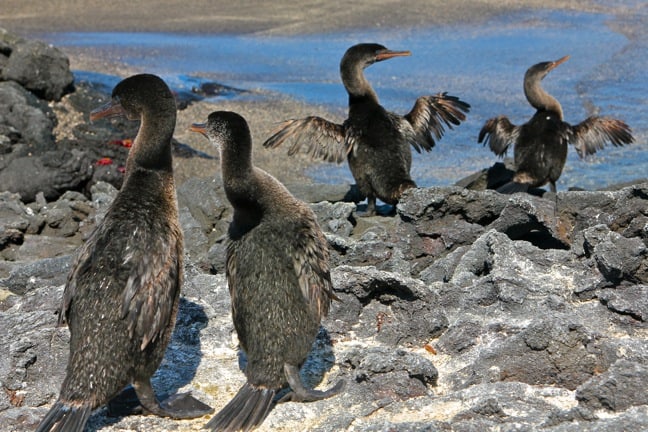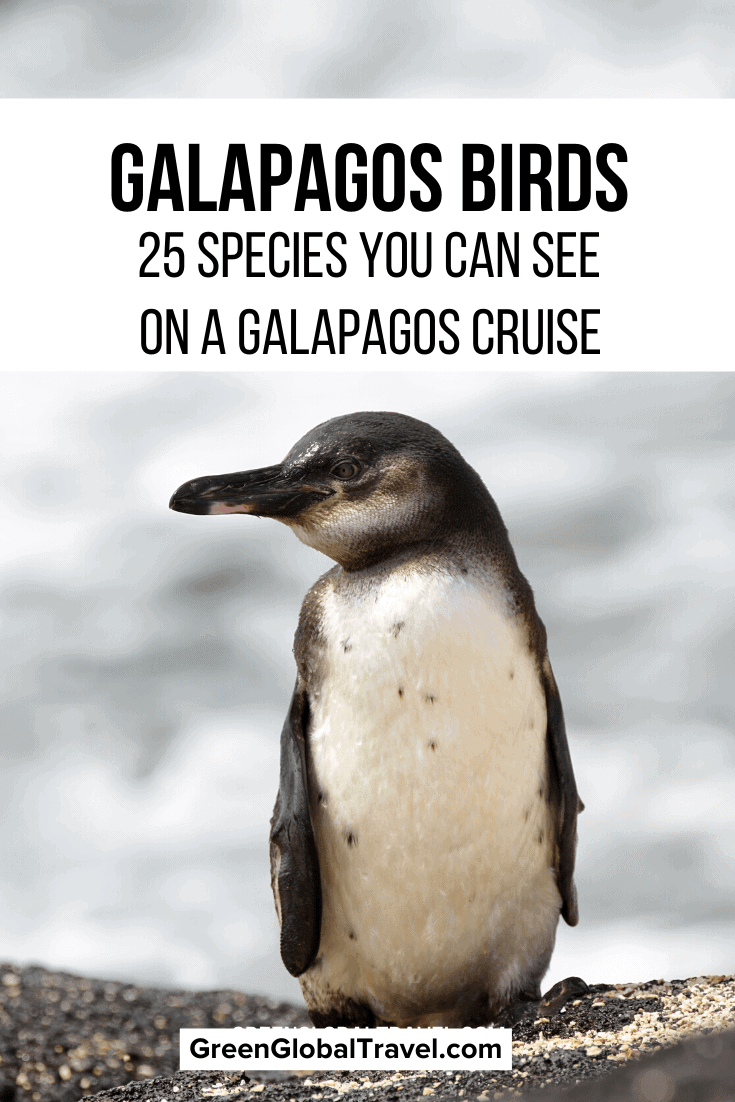We had no idea what to expect when Ecoventura invited us to join their small ship Galapagos cruise in 2011. All we knew was that Galapagos animals had played a huge role in Charles Darwin’s theory of evolution after the Voyage of the Beagle in the 1830s.
During the first of our two Galapagos Islands tours, we were blown away by the sheer diversity of Galapagos birds that could be found in shockingly close proximity.
On the first day we walked around 100 yards on Genovesa Island over a few hours and saw feeding Lava Herons, tiny Darwin’s Finches, Magnificent Frigates soaring overhead, and Nazca and Red-Footed Boobies in trees less than 10 feet away.
On every island we visited during that first Galapagos trip, we found the birds of the Galapagos everywhere we looked. There were Swallow-tailed Gulls on the beach, Blue-footed Boobies on the rocks, and Lava Herons along the shore.
There were so many fluffy babies in nests near the ground, we were simply astounded by the sight.
During a Galapagos Islands cruise with International Expeditions a few years later, we were fortunate enough to swim with a pair of friendly Galapagos Penguins, snorkel with Flightless Cormorants feeding on algae, and see a Waved Albatross mating ritual.
What follows is a sampling of the diverse array of birds in the Galapagos you may see during your own Galapagos vacation.
READ MORE: 30 Galapagos Islands Animals
GUIDE TO GALAPAGOS BIRDS
- Blue-footed Booby
- Nazca Booby
- Red-footed Booby
- Flightless Cormorant
- Galapagos Crake
- Galapagos Dove
- Galapagos Hawk
- Darwin’s Finches
- Galapagos Flamingo
- Galapagos Flycatcher
- Magnificent Frigatebird
- Lava Gull
- Lava Heron
- Mangrove Warbler
- Galapagos Martin
- Galapagos Mockingbird
- American Oystercatcher
- Galapagos Penguin
- Galapagos Brown Pelican
- Galapagos Petrel
- Galapagos Short-Eared Owl
- Red-Billed Tropicbird
- Swallow-Tailed Gull
- Waved Albatross
- Galapagos White-Cheeked Pintail
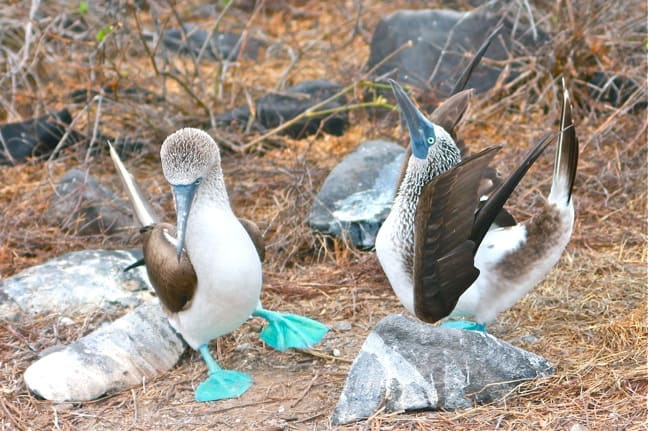
1. Blue-footed Booby
Latin Name: Sula nebouxii
Habitat: Western coast of Central and South America
Size: Length: 32 to 34 inches; Weight: 3.3 to 4.85 pounds
Diet: Mackerel, anchovies, sardines, squid
Conservation Status: Least Concern, population stable
The Blue-footed Booby is easily identified by its bright baby blue feet and face. Other distinguishable characteristics of this booby are their long necks engulfed in white plumage, with all brown wings and long feathered tails that stand up straight.
Females tend to have darker colored feet and will choose their mate based on which male’s feet are the brightest, as this is also an indicator of their overall health.
The Blue-footed Booby dance is an intricate courtship ritual where the male brings the female a generous gift of a rock or stick. He then turns his head, tail, and wings up to the sky and parades around while whistling and taking high steps to display his feet.
If all goes well and a match is made, then the male booby doesn’t have to worry about perfecting another performance, as pairs will often mate for life.
Once the female reproduces, both parents take turns watching over the nest, using their large feet for incubating the eggs. They have large nesting colonies close to the shores of North Seymour and many other islands south of the equator.
To feed, they take spectacular 20-meter dives into the water at 60 mph, snatching up anchovies and sardines with their sharp beaks.
READ MORE: 40 Fascinating Blue Whale Facts
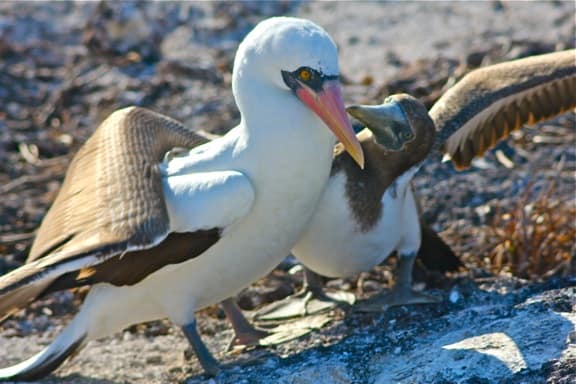
2. Nazca Booby
Latin Name: Sula granti
Habitat: Coastlines of Galapagos archipelago and coastal regions of Central and South America
Size: Length: 30 to 35 in; Weight: 3 to 5 pounds
Diet: Halfbeak, flying fish, tuna
Conservation Status: Least Concern, population decreasing
Nazca Boobies are the largest of the Galapagos booby species.
They are mostly white, with chocolate dipped wings and black faces (the source of their former name, the Masked Booby). Males have big, bright orange beaks, while female’s beaks are a lighter pinkish shade.
Nazca Boobies often wander the coastlines of the Galapagos archipelago, and can also be found in the coastal regions of Central America and South America, as well as Mapelo Island in Colombia.
When it’s time for a Nazca Bobby to breed (between November and February), an unusual process occurs called “obligate siblicide.”
Basically, the female has two chicks, but only one of them survives and grows into adulthood. The smaller chick dies from a failing metabolic system, leaving the larger one better able take care of itself.
Like other booby species, Nazcas face threats from human development throughout their habitat, especially from fishing equipment such as long lines.
READ MORE: Exploring Tayrona National Park, Colombia
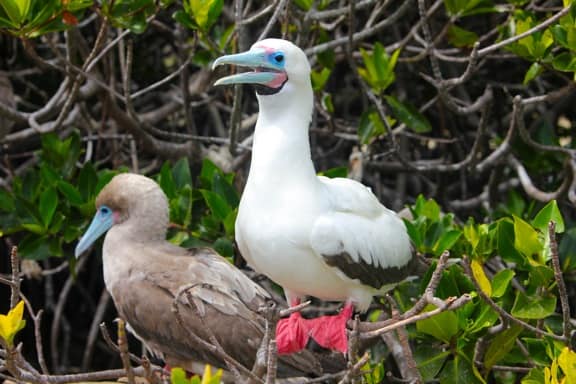
3. Red-footed Booby
Latin Name: Sula sula
Habitat: Tropical and subtropical regions of the Indian, Atlantic, and Pacific Oceans
Size: Length: 25 to 30 in; Weight: 1.87 to 2.43 pounds
Diet: Squid, fish
Conservation Status: Least Concern, population decreasing
Wandering the shores of Genovesa and San Cristobal Islands, Red-footed Boobies are easily distinguishable Galapagos seabirds with bright red feet and sky blue beaks. Out of over half a dozen different booby species, they are the smallest and most abundant.
The Red-footed Booby is a clumsy and awkward walking bird. Boobies get their peculiar name from the Spanish word bobo, meaning foolish or clown.
These Galapagos boobies reign over the coasts in large hunting groups, flying up to 93 miles to capture fish. They’re excellent divers, able to plunge down off of cliff sides and catch flying fish as they jump into the air.
At night, they dive into the water in search of squid. Unlike many animals, the female Red-footed Booby is larger than the male. Mating season occurs about every 15 months, and the female only lays one egg. They have a long average lifespan of over 20 years.
While this specific Galapagos bird species is currently listed as least concern by the IUCN, their population in the archipelago has been reduced by predatory invasive species and habitat loss.
READ MORE: Darwin’s Paradise (Our Galapagos Islands Cruise Adventure)
4. Flightless Cormorant/Galapagos Cormorant
Latin Name: Nannopterum harrisi
Habitat: Rocky shores of volcanic islands
Size: Length: 2.9 to 3.2 feet; Weight 5.5 to 11 pounds
Diet: Fish, octopus, squid
Conservation Status: Vulnerable, population stable
Flightless Cormorants are one of the rarest birds in the world, with less than 1000 left in the wild. One of the endemic birds of the Galapagos Islands, they’re confined to the shorelines of Isabela and Fernandina.
Of the world’s 29 different cormorant species, they’re the only birds that cannot fly.
Also known as the Galapagos Cormorant, the bird’s wings are just one-third the size they’d need to fly. This is because their lack of land-based predators led them to evolve away from having big wings in favor of becoming stronger swimmers.
They’re able to dive deep into the sea and catch eels, fish, and octopus. However, their feathers aren’t waterproof, so they spend a lot of time drying their short, stubby appendages in the sunlight.
Black heads surround their brilliant turquoise eyes, followed by a long, brown neck that allows them to peer above the water while swimming.
Their flexible necks also serve as a mating tool. In courtship rituals, couples intertwine their necks while twirling in circles together above the water. After finishing their ballroom dance, the two will find a spot on land to build a rocky nest together.
Check out our rare footage of Flightless Cormorants in Galapagos swimming together in a courtship dance. These video images are so rare that even our 20-year veteran Galapagos tour guide had never seen it before!
READ MORE: Flightless Cormorant Mating Dance
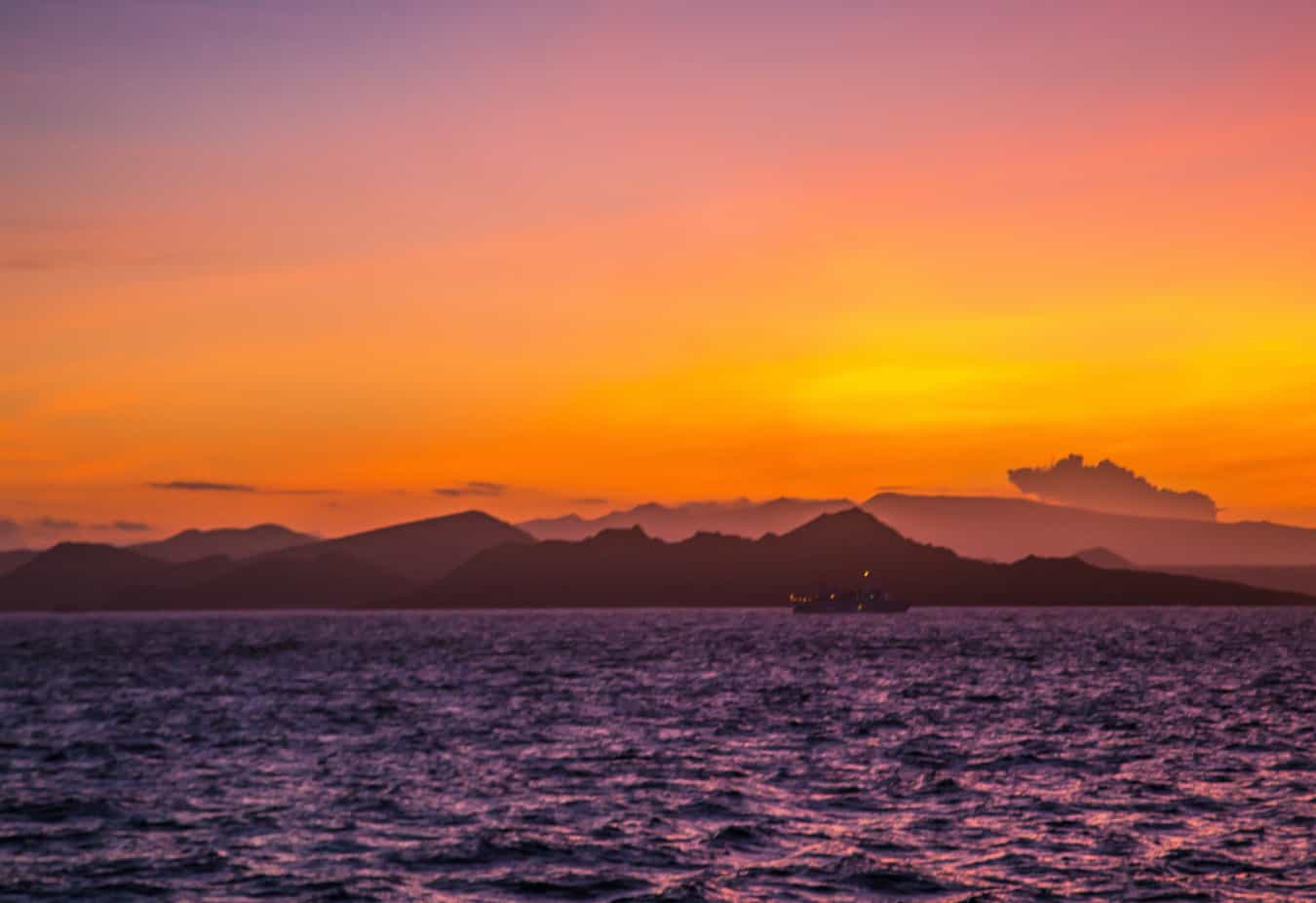
5. Galapagos Crake
Latin Name: Laterallus spilonota
Habitat: Galapagos islands with higher elevations
Size:Length: 5.9 to 6.2 inches; Weight: 1.23 to 1.57 oz
Diet: Snails, dragonflies, ants, bugs, berries, seeds
Conservation Status: Vulnerable, population decreasing
The Galapagos Crake (also known as the Galapagos Rail) is a short, stubby grey bird with tiny red eyes. Its wings are light brown and dotted with small white specks. But they’re practically useless, as it can only fly a few meters at a time.
The Crake and many other native Galapagos bird species are considered vulnerable (and are presumed to be extinct from Floreana Island) after invasive species such as rats, cats, dogs, goats, and cattle were introduced to the island by humans.
Now these birds are only found roaming the dense, moist highland grounds of the archipelago’s other major islands. There, they eat a variety of invertebrates, such as snails, ants, and other bugs.
They also form monogamous relationships, with both parents taking turns incubating their eggs before hatching. One interesting trait of the Crake is their diverse vocality, as they can often be heard making a wide range of different sounds and noises.
READ MORE: Charles Darwin Foundation Director on Galapagos Conservation
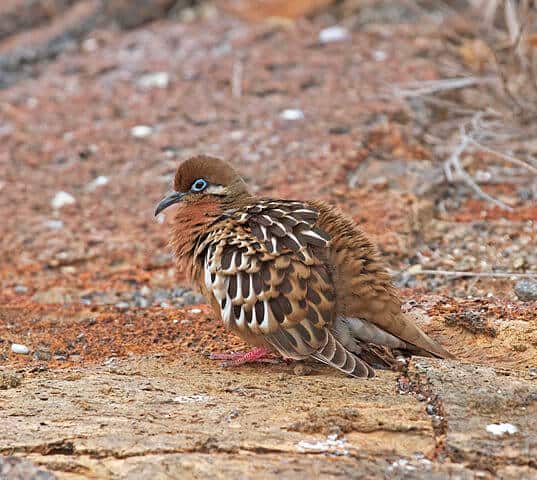
6. Galapagos Dove
Latin Name: Zenaida galapagoensis
Habitat: Rocky, arid and semi-arid lowlands
Size: Length: 7 to 9 in; Weight: 2.3 to 3.2 oz
Diet: Caterpillars, seeds, fruits, fly larvae, pupa
Conservation Status: Least Concern, Stable
As one of the most common Galapagos bird species, the Galapagos Dove is endemic to the islands and has a relatively small range.
Historically known for landing on the hats and shoulders of early sailors, these are very tame and gentle birds. Unfortunately, the birds’ fearlessness also made them easy meals for those hungry sailors.
Their plumage includes varying shades of brown, red, grey and white, with pink feet and bright blue rings around the eyes.
They usually stay close to the ground, inhabiting dry, rocky lowlands, where they feed on seeds, caterpillars, and cacti blossoms by using their downward pointed beaks.
Due to the lack of bees, evolution has caused the spines of the island’s cactus plants to soften over time, allowing the Galapagos Dove to pollinate its flowers.
The cactus pulp also helps hydrate the birds, as there are few fresh water sources on the islands.
READ MORE: Organic Beekeeping in the Jezersko Valley, Slovenia
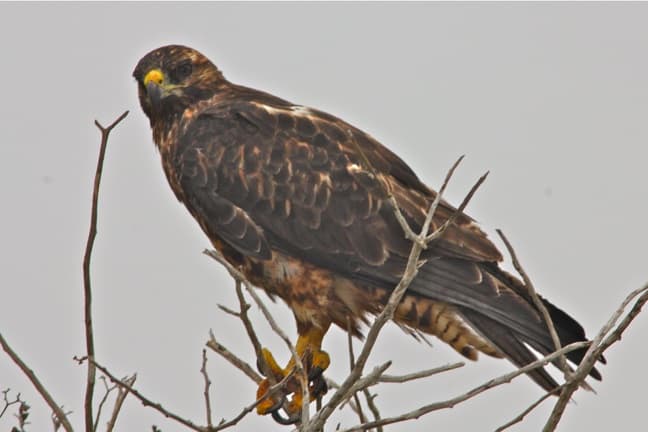
7. Galapagos Hawk
Latin Name: Buteo galapagoensis
Habitat: Shoreline and deciduous forests of the Galapagos islands
Size: Length: 18 to 23 in; Weight: 1.43 to 1.87 pounds
Diet: Rodents, birds, lizards, sea turtles, insects
Conservation Status: Vulnerable, population stable
Endemic to the Galapagos Islands, the Galapagos Hawk reigns over the islands as its top bird of prey. With few natural predators in the Galapagos, these hunters of the sky play a vital role in the local ecosystem.
They are one of the world’s rarest raptors, with an estimated population size of just 150 breeding pairs. Similar in size to the North American Red-tailed Hawk, they are striking in appearance, with bronze eyes and a plumage of multiple shades of brown.
Using their sharp beaks and claws, Galapagos Hawks prey on lizards, snakes, rodents, Marine Iguanas, and the occasional Sea Turtle hatchling. They also feast on carrion, even that which is too rancid for other animals to eat.
These hawks participate in a rare, unique breeding practice called cooperative polyandry. The male remains monogamous during the nesting period, but the female may have up to seven different mates.
These mates ultimately help her raise hatchlings by feeding them and taking turns incubating eggs.
READ MORE: International Galapagos Tour Operators Association Q&A

8. Darwin’s Finches
Latin Name: Geospizinae subfamily
Habitat: Galapagos islands and Cocos island
Size: Length: 3.9 to 4.72 in; Weight: 0.2 to 1.34 oz
Diet: Pollen, nectar, opuntia seeds, fruit
Conservation Status: Population decreasing
Named for their pivotal role in Charles Darwin’s theory of evolution, there are 13 species of finches in the Galapagos Islands.
After studying the Galapagos finches for five weeks, Darwin developed a theory that, despite their genetic diversity, all 13 species had evolved from a single species that migrated to the volcanic islands a few million years ago from mainland South America.
This finch species then genetically adapted to the selective pressures of the differing islands.
Different body and beak sizes helped the ancestral ground dwelling seed-eaters transform their diets and adapt to various habitats. Through speciation, they now also feast on insects, flowers, leaves, and even the blood of seabirds.
Galapagos Island Finches are considered to be one of the world’s fastest-evolving vertebrates because of how quickly they adapted to such a rapidly changing environment.
Despite subtle plumage variations and unique beak shapes, each species is very similar in appearance. They’re most easily identified by the differences in their diets.
READ MORE: How to Attract Birds To Your Garden
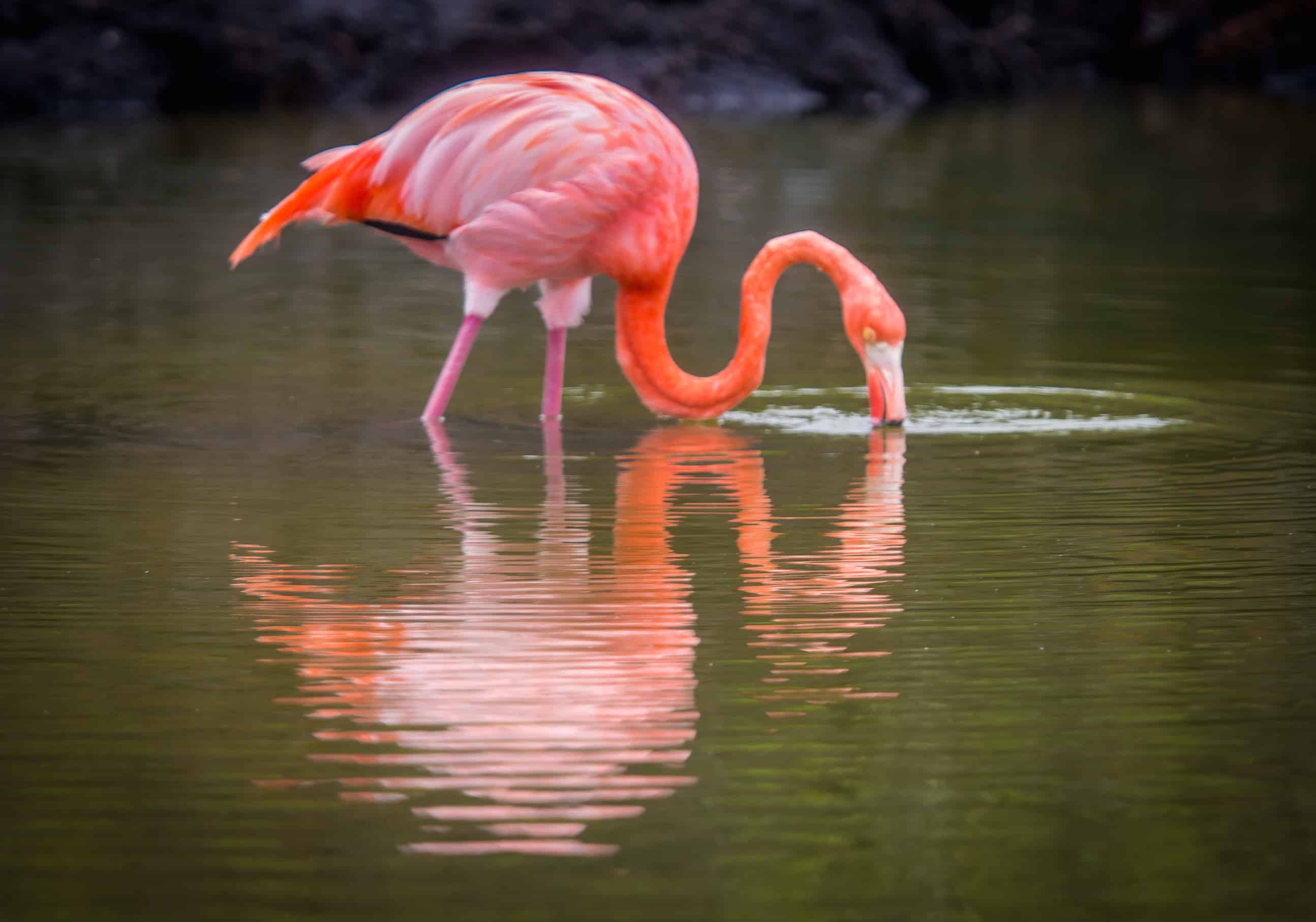
9. Galapagos Flamingo
Latin Name: Phoenicopterus Ruber
Habitat: Shallow waters off the coast of Ecuador
Size: Length: 47.2 to 55 in; Weight: 4.85 to 6.17 pounds
Diet: Water plants, crustaceans
Conservation Status: Least Concern, population increasing
With less than 350 individuals remaining in the wild, the Galapagos Flamingo is the world’s smallest, and is currently listed as Endangered by the IUCN.
Their stunning rosy pink feathers actually come from their diet, from a natural pigment called carotenoids, which is found within the crustaceans that they love to eat. Chicks are born grey and white, and don’t develop their signature bright coloring for two to three years.
To rest their long, skinny legs, they are often sighted standing on only one of them, with the other tucked under their bodies.
These peculiar birds are highly sociable, living in colonies throughout the shallow island waters of Floreana, Isabela, Santiago, Rabida, and Santa Cruz. They do this not only for protection, but for group mating rituals as well.
However, they are believed to be monogamous, staying with the same mate for life. What’s truly fascinating about Flamingo mates is that both the male and female can produce milk for their chicks!
READ MORE: 5 Endangered Species that Mate For Life
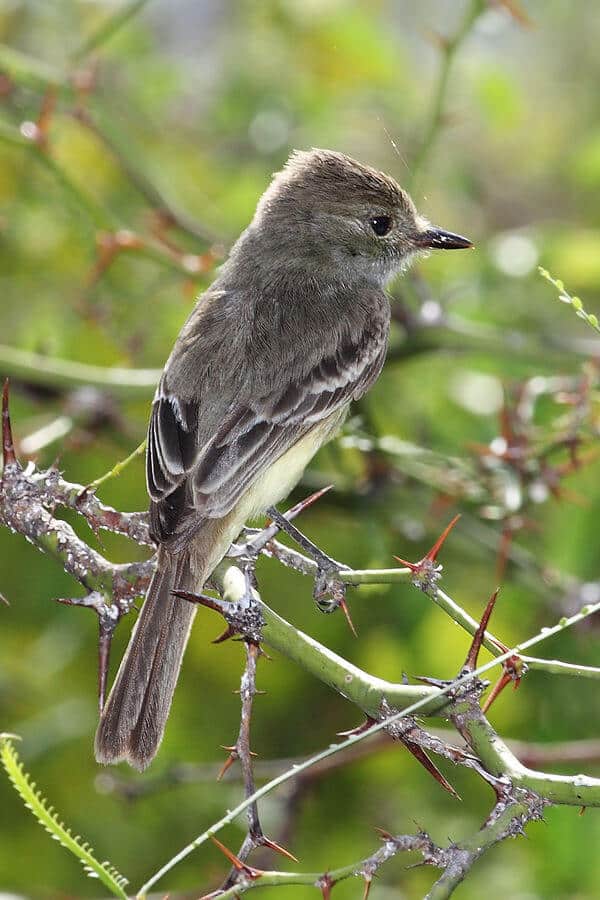
10. Galapagos Flycatcher
Latin Name: Myiarchus magnirostris
Habitat: Dry forests and tropical arid shrubland
Size: Length: 5.9 to 6.3 in; Weight: 0.4 to 0.65 oz
Diet: Insects
Conservation Status: Least Concern, population decreasing
Also known as the Large-Billed Flycatcher, this endemic species is found on all of the Galapagos Islands, primarily in tropical dry forests and tropical arid shrubland. It’s the smallest member of its genus, with an average length of 5.9 to 6.3 inches.
These tiny, round Galapagos birds have big dark eyes and are light brown in color, with feathered crests at the top of their heads that can either be ruffled out or swooped back. Males also have bright yellow bellies.
Despite their size, they’re very curious and fearless birds, and are known for being attracted to tourists with large camera lenses.
They are avid singers, producing a variety of high-pitched, squeaky sounds. Using their short, but wide beaks, they’re able to catch flying insects to eat as they move around tree perches.
During the hot, wet season between December and March, they build their nests high above the ground, usually in holes of trees or cacti. Nesting sites can’t be too close to other Galapagos Flycatchers though, as they tend to be highly territorial.
READ MORE: The 30 Best Exotic Islands to Visit
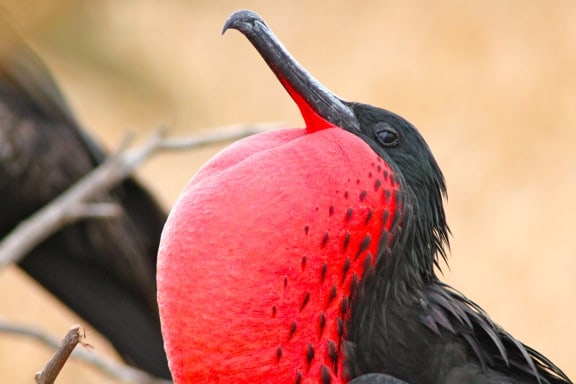
11. Magnificent Frigatebird
Latin Name: Fregata magnificens
Habitat: Along the coasts and islands of tropical and subtropical water
Size: Length: 35 to 44.9 in; Weight: 2.2 to 4.18 pounds
Diet: Flying fish, tuna, herring, squid
Conservation Status: Least Concern, population increasing
The Magnificent Frigate is not endemic to the Galapagos, but it is one of its most impressive inhabitants. With bodies up to 45 inches long, they have the largest wingspan-to-body weight ratio of any bird in the world.
These fantastic fliers soar effortlessly through the skies, often gliding on the air currents created by ships. They never land in water, feeding by snatching fish from the ocean’s surface.
Nicknamed the “pirate bird,” they will also eat by forcing other birds to regurgitate their meal so they can steal it.
During mating season, males inflate their red throat pouches dramatically to attract females, making for fantastic photos. We’d seen frigate birds in Galapagos nesting near the ground on Genovesa, and hovering in the air nearly everywhere we went.
But it wasn’t until we explored North Seymour that we finally saw the brilliant red inflated pouches of Magnificent Frigate birds hoping to impress potential mates. The tiny black feathers sticking out only made the rich color that much more striking.
READ MORE: The World’s Best Small Ship Cruises
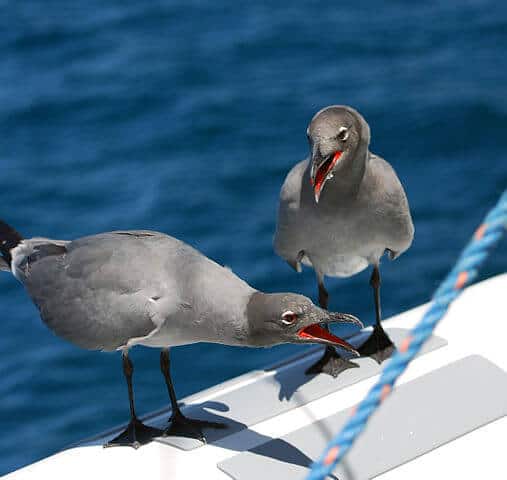
12. Lava Gull
Latin Name: Leucophaeus fuliginosus
Habitat: Sheltered regions of coastal lagoons in the Galapagos
Size: Length: 20 to 22 inches; Weight: 13 oz
Diet: Fish, crustaceans, newly hatched lizards, turtles, and iguanas
Conservation Status: Vulnerable, population stable
Endemic to the Galapagos, this is the rarest gull species in the world, with a population of 900-1,200 leading to their current IUCN listing as Vulnerable. Restricted to the archipelago, they reside along the islands’ rocky, sandy coasts.
Adult plumage is mostly grey with black and white accents, which are believed to help with camouflage. It may surprise you when they open their mouths to reveal an unexpected scarlet coloring inside.
Typically seen in single pairs rather than colonies, they nest on low outcroppings near calm waters, where they usually lay two eggs.
Unlike other species of gulls, they’re solitary nesters and are very defensive of their breeding grounds, as they face threats from other Lava Gulls, Owls, and introduced mammals.
These omnivorous scavengers will often feed on seabird eggs, juvenile Marine Iguanas and Sea Turtles, fish, and small crustaceans. They make squawking noises, similar to their close relative the Laughing Gull.
READ MORE: The Best Volcanoes in the United States
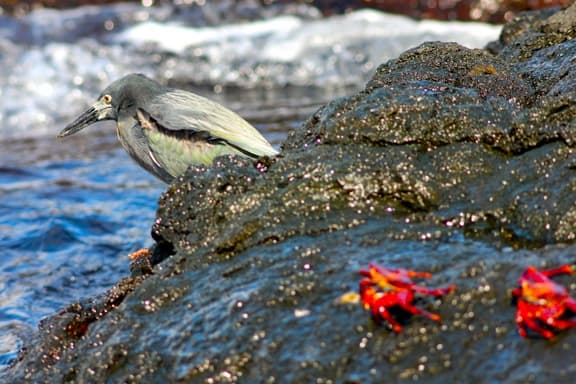
13. Lava Heron
Latin Name: Butorides sundevalli
Habitat: Lava rock coastlines, saltwater lagoons, mangrove forests
Size: Length: 14 in;Weight: 6.8 to 8.3 oz
Diet: Crabs, fish, flies, smaller birds
Conservation Status: Data deficient
Aside from its bright yellow eyes, the Lava Heron is covered in dusty, silver feathers with a charcoal thin beak. Their coloring allows them to perfectly camouflage among the grey basalt rocks of the Galapagos Islands.
During their breeding season, the male’s dark legs miraculously turn to orange and their beaks darken to black. These little birds are quite the hopeless romantics, as they tend to remain monogamous and will breed about three times throughout the year.
They get their name from their common nesting spot along the volcanic lava rock coastlines. On the shore they use their sharp, long beaks to quickly stab small fish and Sally Lightfoot crabs like a spear. They can catch their food at a rate of two to three per minute.
While their population numbers remain bountiful across the island, invasive Galapagos Islands wildlife such as feral cats, rats, and pigs pose threats to their eggs and hatchlings.
READ MORE: The Top 10 Volcanoes for Your World Travel Bucket List
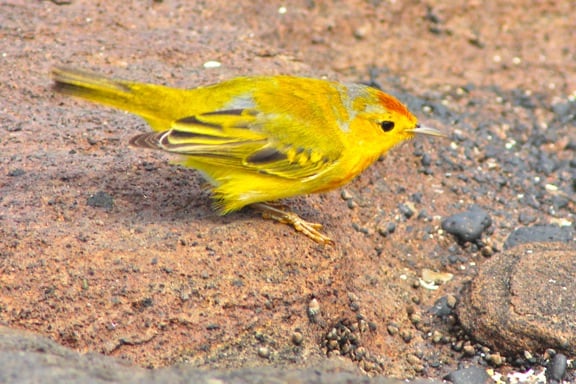
14. Mangrove Warbler/Yellow Warbler
Latin Name: Setophaga petechia
Habitat: Shrubby thickets and woods in wetlands & mangrove forests in Central/ South America
Size: Length: 4.9 in; Weight: 0.39 oz
Diet: Insects, berries
Conservation Status: Least Concern, population stable
This colorful bird is a subspecies of American Yellow Warbler, which are widespread throughout North America and the northern part of South America.
Their genus name, Setophaga, comes from ancient Greek for “moth-eating,” and they’re commonly known as the “summer yellowbird.”
Found primarily in mangrove swamps. the 12 species of Mangrove Warblers tend to be larger than other yellow warbler subspecies. They average around 4.9 inches long and .4 ounces in weight.
The Galapagos Mangrove Warbler– scientific name Setophaga petechia aureola– can be identified by its brilliant yellow feathers, reddish-brown hood or crown and chest streaks, grey to black wing and tail streaks, and sweet sounding song.
They can often be seen in the Galapagos Islands in mangrove forests and along the shoreline, where they feed on insects, other invertebrates, and occasionally small fruits. Caterpillars are a favorite food among baby birds, especially those of Geometer Moths.
Unfortunately, though the Galapagos lacks many of the predators that feed on warblers on the mainland, they do have to worry about Hawks, Owls, and other birds of prey.
They may also be affected by pesticide use, as well as the parasitic fly Philornis downsi.
READ MORE: Can Maritime Forests Survive Climate Change?
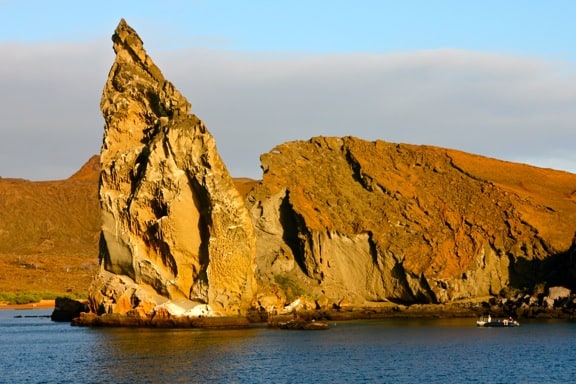
15. Galapagos Martin
Latin Name: Progne modesta
Habitat: Subtropical or tropical dry shrubland, low grassland, and pastureland
Size: Length: 5.9 in
Diet: Butterflies, moths
Conservation Status: Endangered, population decreasing
The sighting of a Galapagos Martin is extremely rare. So much so that these mysterious birds of the Galapagos have never been studied before, and it is unknown how many may still exist in the wild.
Endemic to the Galapagos Islands, they’re beautiful in appearance, with a sapphire blue head and torso that flows into dark, ash-tipped feathers.
Their tiny size makes them excellent hiders, forming their nests in between the cracks and crevices of high sea cliffs, which are often too dangerous for humans to reach. From their concealed homes they feed on flying insects, such as moths and butterflies.
While not much is yet known about this secretive little Galapagos bird, they face possible danger from the invasive, parasitic Philornis Downsi fly. The flies’ larvae feed off the blood of newborn chicks.
More than 18 different species of Galapagos birds are seriously threatened by this insect.
READ MORE: 10 Invasive Species You Can Eat
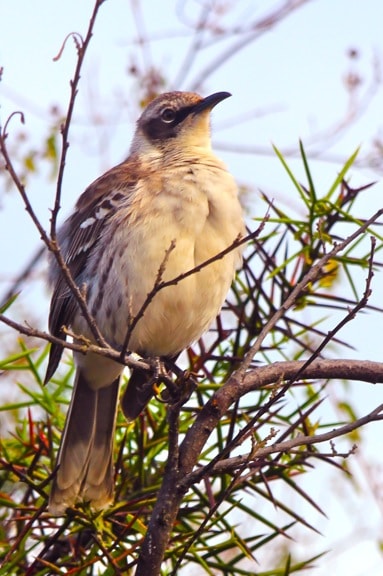
16. Galapagos Mockingbird
Latin Name: Mimus parvulus
Habitat: Arid lowlands, woodlands, moist high forests
Size: Length: 9.8 to 10.2 in; Weight: 1.79 to 1.97 oz
Diet: Caterpillars, orthopterans, centipedes, fruit, nectar
Conservation Status: Least Concern, population stable
With six subspecies– each of which is endemic to particular island regions across the archipelago– this long-tailed, long-legged, long-beaked bird is the most widespread of the mockingbird species found in the Galapagos.
The tiny grey omnivore eats almost everything– seeds, eggs, fruit and more– and studies show that they distribute viable seeds across the islands after digesting them.
Despite their names, these mockingbirds do not mimic the calls of other small creatures, but they do have a variety of calls that are all used for different reasons. One call in particular is used to alert others of possible danger.
Marine Iguanas have learned to recognize these alarm calls to their advantage, as they face many of the same predators as the Galapagos Mockingbird.
While this type of behavior has been exhibited between other species before, this is the first record of a reaction by a non-vocalizing species such as the Iguana.
READ MORE: Marine Iguanas of the Galapagos Islands (With Video)
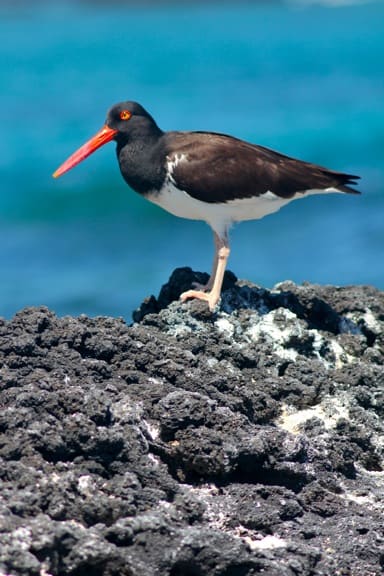
17. American Oystercatcher
Latin Name: Haematopus palliatus
Habitat: Barrier islands and beaches, saltmarshes, shellfish reefs
Size: Length: 15.8 to 17.3 in; Weight: 0.88 to 1.54 pounds
Diet: Oysters, mollusks, fiddler crabs
Conservation Status: Least Concern, population stable
Despite nearly being hunted to extinction in the 19th century for its distinctive plumage and eggs, the American Oystercatcher has recovered considerably since Migratory Bird Treaty Act was passed in 1918.
They are now listed as a species of “Least Concern” by the IUCN, with an estimated population of around 43,000. They’re found on beaches and coastal areas throughout much of the Americas, from the Atlantic and Gulf of Mexico south to Chile and Argentina.
The bird is identified by its black head and breast, greyish-black wings and tail, white underparts and inner wing, and long orange beak. They also have yellow irises, with orange orbital rings around the eyes and pink legs. Adults usually measure 17 to 20 inches long.
The migratory species is often seen on beaches, dunes, salt marshes, and mudflats exposed by the tide. They use their strong beaks to pry open bivalve mollusks, feeding on oysters, mussels, clams, sea urchins, crabs, and other marine invertebrates.
Oystercatchers breed between April and July starting around age three, with mating pairs often walking together and calling in unison. This is followed by leaning in, lowering their necks, and either running side-by-side or bursting into flight.
Nests are scraped into the sand (usually around 8 inches wide and 2.5 inches deep), then lined with shells and pebbles. They ultimately raise a clutch of two to four eggs, with both parents incubating them for around 26 days. Chicks are a downy tan, and can run within two hours.
READ MORE: Pleasure House Oysters Helps Restore Chesapeake Bay
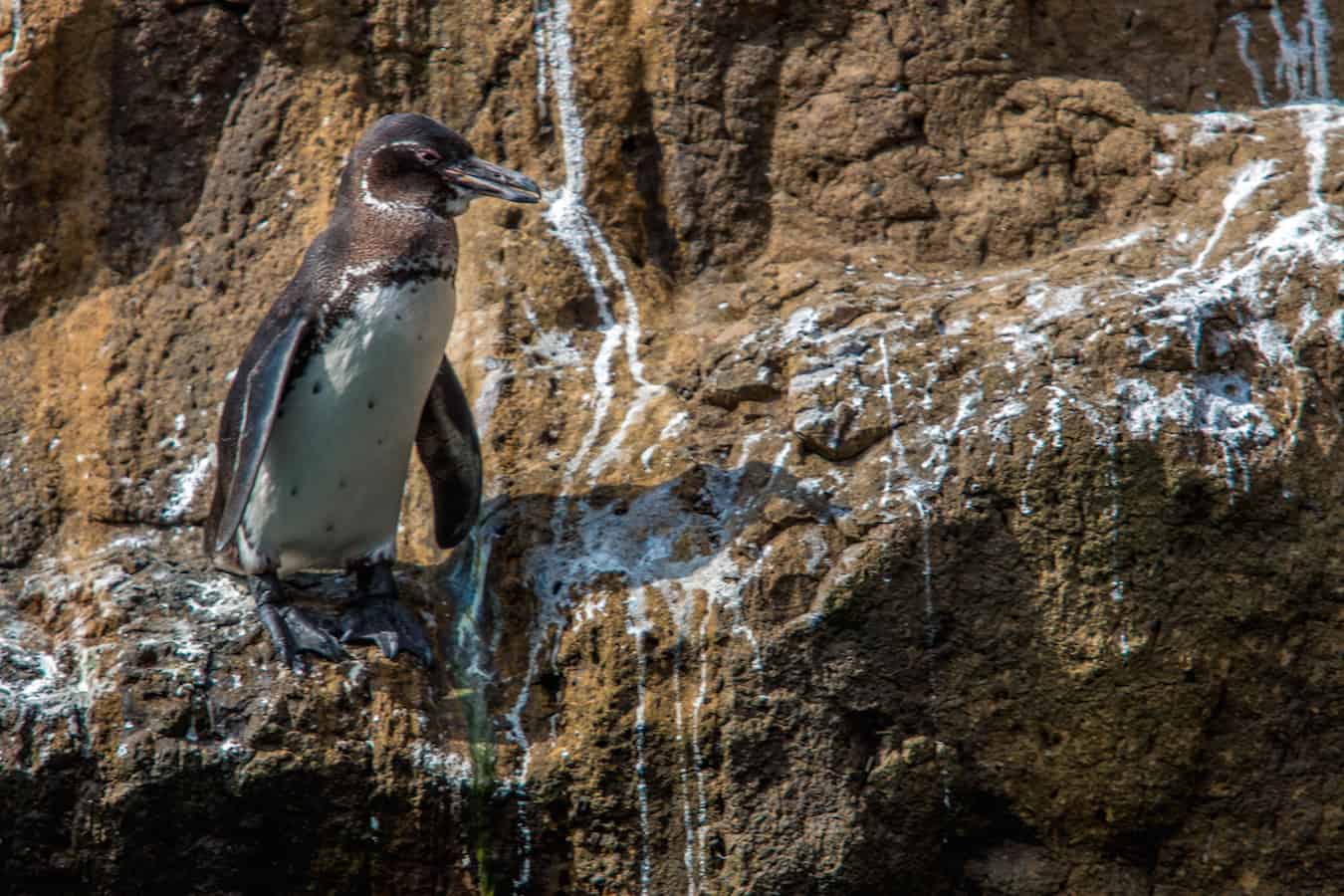
18. Galapagos Penguin
Latin Name: Spheniscus mendiculus
Habitat: Rocky shores and reefs
Size: Length: 21 in; Weight: 4 to 6 pounds
Diet: Sardines, anchovies, mullet
Conservation Status: Endangered, population decreasing
The Galapagos Penguin population is less than 1,000 breeding pairs. Found primarily on the islands of Fernandina and Isabela, they measure 19 inches long and weigh around five pounds, making them the world’s second smallest penguin species.
The diminutive Galapagos Islands Penguins are the only tropical penguins found north of the equator.
Scientists believe their Antarctic Penguin ancestors got caught in the Humboldt Current and wound up in the Galapagos, where they genetically adapted to the heat and now cool themselves off via thermoregulation.
However, like most penguins, they still favor cooler temperatures, breeding when the sea surface temperature drops below 77 degrees. To stay cool they pant, similar to dogs, and will also lay their eggs in deep rock crevices to avoid overheating in the sun.
Snorkeling with them is a once-in-a-lifetime experience, as they dive and dart through the waves like tiny torpedoes while hunting the schooling fish that make up the bulk of their diet.
READ MORE: Secrets to Swimming with Galapagos Penguins
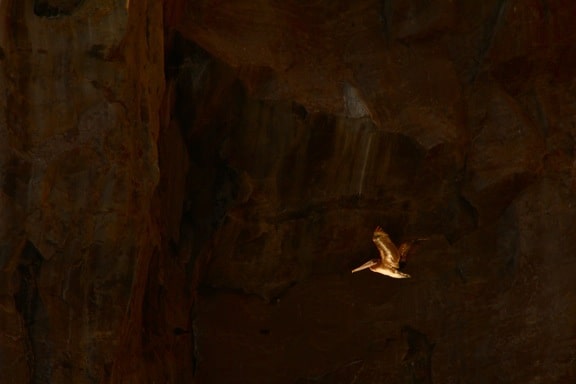
19. Galapagos Brown Pelican
Latin Name: Pelecanus occidentalis
Habitat: Atlantic, Gulf, and Pacific Coasts in the Americas
Size: Length: 41 in; Weight: 7 to 11 pounds
Diet: Fish, amphibians, crustaceans, eggs
Conservation Status: Least Concern
The Brown Pelican is one of three pelican species found in the Americas, and one of two that dives to feed on fish. Its range extends along the Atlantic coast from Nova Scotia south to the mouth of the Amazon River, and along the Pacific from British Columbia to Chile.
Their scientific name is Pelecanus occidentalis, with P.o. urinator the name for the subspecies which is found only in the Galapagos Islands.
Like its cousins, during breeding season the Galapagos Brown Pelican has a white head with a yellow crown, a deep maroon to brown nape and neck, and a yellow patch on the lower neck.
Male and female pelicans look similar, but the latter is a little smaller. They nest in secluded colonies, usually in thick foliage, sand dunes, and mangroves.
Females lay 2-3 eggs, and both sexes share incubation duties for 28 to 30 days. Newly hatched chicks are pink, ultimately turning grey or black, and leave the nest about six to nine weeks later to form pods.
Interestingly, President Theodore Roosevelt created the first National Wildlife Refuge (Pelican Island in Florida) in order to protect the Brown Pelican from hunters.
The species was on the Endangered Species list from 1970 to 2009 due to the use of harmful pesticides such as DDT.
But after DDT was banned in the 1970s, the Brown Pelican population increased dramatically. They’re currently listed as a species of least concern by the IUCN.
READ MORE: List of U.S. National Parks By State (an Epic Guide)
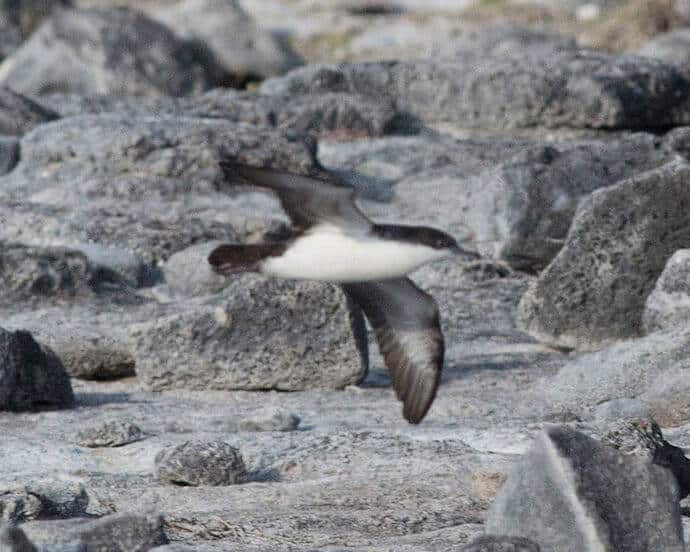
20. Galapagos Petrel
Latin Name: Pterodroma phaeopygia
Habitat: Open sea; breeding season spent in humid highlands of islands
Size: Length: 15.5 to 16.5 in; Weight: 13.6 to 15.3
Diet: Squid, octopuses, fish, crustaceans
Conservation Status: Critically Endangered, population decreasing
Breeding in the humid highlands up to 900 meters above sea level on large islands (Floreana, Isabela, San Cristobal, Santa Cruz and Santiago), the Galapagos Petrel nests in burrows and natural cavities on hillsides.
Unfortunately this made them vulnerable to invasive species such as cats, pigs and especially rats, which feed on their eggs and hatchlings.
The population is gradually recovering and estimated between 10,000-20,000 individuals. But the species remains listed as Critically Endangered by the IUCN due to impacts from agriculture, invasive plants, and El Niño events.
Island locals commonly refer to them as patapegada, meaning “web-footed one.” These medium-sized seabirds are black all over the top of their bodies, with white under-bellies.
When it’s time to feed, they use their quick and agile flight skills to glide over seas, catching fish, squid, and crustaceans along the way.
Petrel species are distinguished by their beaks, which are short and hooked, with tubular nostrils on the top.
READ MORE: The 20 Best Environmental & Animal Charities To Donate To
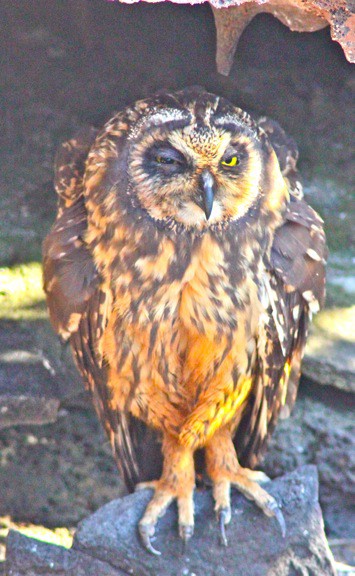
21. Galapagos Short-Eared Owl
Latin Name: Asio flammeus
Habitat: Open grassland or lava rock
Size: Length: 13 to 17 in; Weight: 11 to 13 oz
Diet: Rats, lava lizards, birds
Conservation Status: Least Concern, population decreasing
One of 10 recognized subspecies of Short-eared Owls, Asio flammeus galapagoensis is a medium-sized owl measuring 13 to 17 inches long and weighing seven to 17 ounces, with a wingspan of 33 to 43 inches. Females of the species are slightly larger than males.
This beautiful Galapagos bird boasts big eyes, an oversized head, relatively short neck, and broad wings. Its plumage is gorgeous, mottled with tawny and brown feathers, and a barred tail and wings. The eyes are a vivid yellow, while the black bill is short and hooked.
They use it to feed on a diverse array of prey, from rodents and bats to smaller birds. Arguably their favorite food is the Vole (a.k.a. Field Mice), which is why this is one species of Owl you shouldn’t be surprised to spot during the day. But they do also hunt at night.
The Galapagos Short-eared Owl is typically found in open country and grasslands, but you can occasionally spot them in rocky areas along the coast as well. During breeding season, watch for their irregular, moth-like flying, with males flying erratically to attract females.
They nest on the ground in areas of low vegetation, often lining the nest with feathers, grass, and weeds. Clutch sizes range from four to a dozen eggs, which are primarily incubated by the female. Chicks begin to fledge at around four weeks old.
READ MORE: Alabama Beach Mouse (Endangered Species Spotlight)
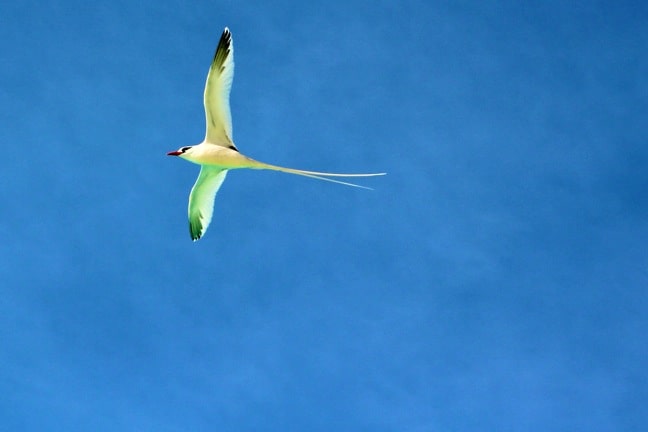
22. Red-Billed Tropicbird
Latin Name: Phaethon aethereus
Habitat: Offshore archipelagoes and islands between the Pacific, Atlantic, and Caribbean tropics
Size: Length: 34 to 41 in; Weight: 1.7 pounds
Diet: Flying fish, squid
Conservation Status: Least Concern, population decreasing
One of three closely related species of seabirds, the Red-billed Tropicbird looks a bit look a Tern with really long tail feathers.
Known as streamers, these feathers (which are longer on males than females) can grow up to two times their total body length. Their bodies are about 19 inches long without the tails, and their wingspans can be up to 42 inches.
Aside from the obvious red bill, they’re identified by their white plumage offset by a black face mask and black markings on their back and wings.
They usually nest on cliff faces in loose colonies, where a single egg will be incubated by both parents for six weeks or so. They’re often seen soaring on wind currents near the shore, diving into the water to feed on fish and squid.
The species is fairly common throughout the tropics, including the southern Atlantic, eastern Pacific, and Indian Oceans. They’re currently listed as a species of Least Concern by the IUCN. But the populations in Brazil and Mexico are currently under threat.
READ MORE: Isla Holbox, Mexico’s Hidden Gem
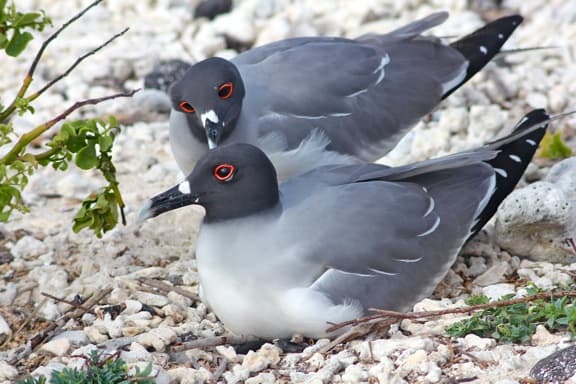
23. Swallow-Tailed Gull
Latin Name: Creagrus furcatus
Habitat: Steep slopes, cliff ledges and gravelly beaches of islands
Size: Length: 20 to 22.44 in; Weight: 1.34 to 1.71 pounds
Diet: Fish, squid
Conservation Status: Least Concern
Another endemic Galapagos bird species, the Swallow-Tailed Gull is the only fully nocturnal seabird in the world. This trait benefits them by allowing them to feed on squid and fish that rise to the sea surface at night in search of plankton.
It is also the only species in the genus Creagrus, deriving from the latin word for butcher or meat, which refers to the bird’s hooked beak.
Their defining feature is their large, striking, red-ringed eyes, which help them to see in the dark and stand out amongst their jet black heads. They have black-tipped tails to match, while the rest of their body is white and grey, with salmon pink legs and webbed feet.
Preferring warmer temperatures, they usually live in small colonies along the eastern coasts of the archipelago. Mating pairs frequently stay together to breed each year, nesting on steep slopes, ledges, and just above the wave line on gravelly beaches.
READ MORE: The World’s Most Colorful Beaches
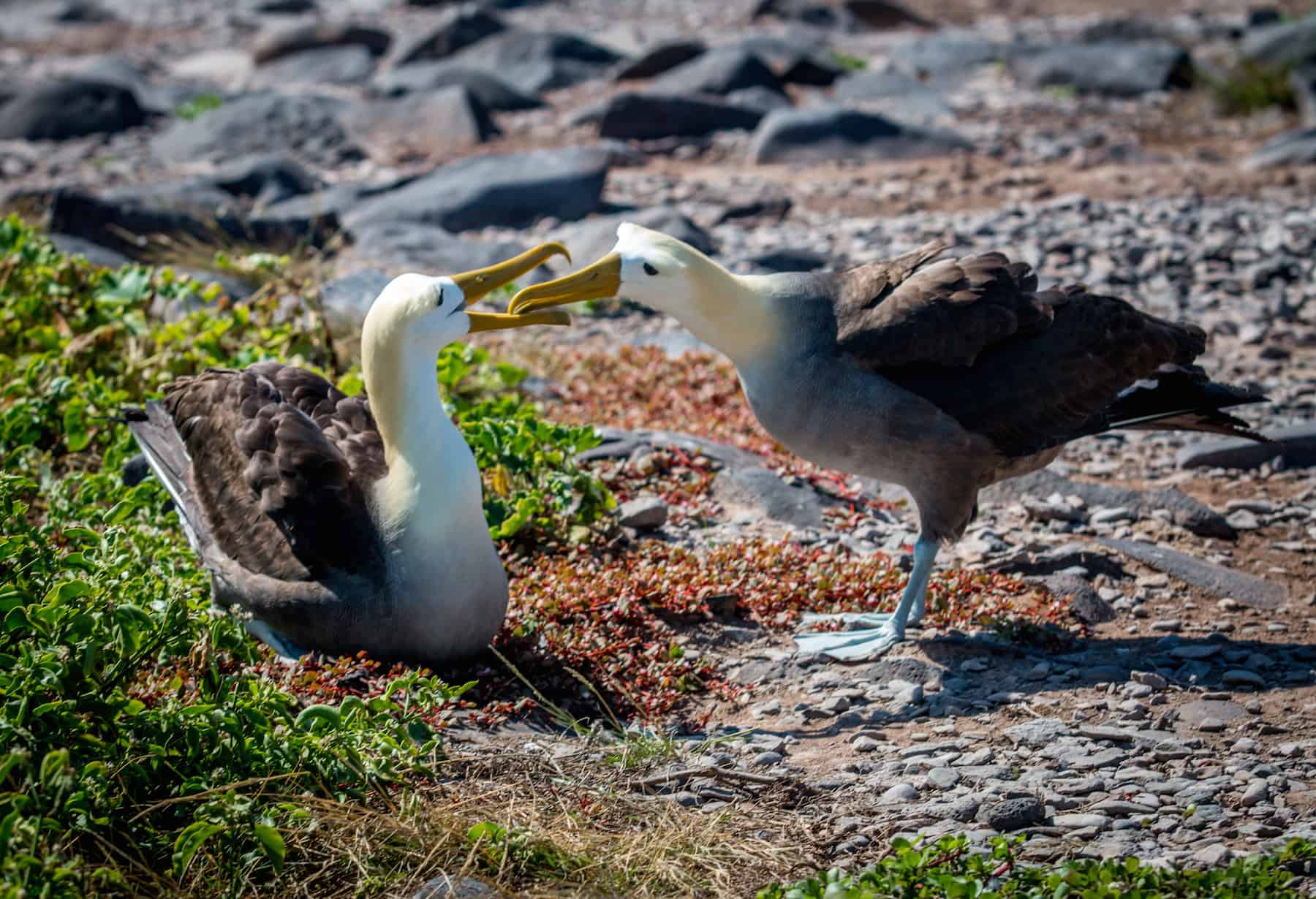
24. Waved Albatross/Galapagos Albatross
Latin Name: Phoebastria irrorata
Habitat: Galapagos Islands of Espanola and coastal waters of Chile, Peru, Colombia, & Ecuador
Size: Length: 31 to 25 in; Weight: 7.4 pounds
Diet: Squid, fish, crustaceans, smaller birds
Conservation Status: Critically Endangered, population decreasing
With an incredible wingspan of up to 8 feet, the Waved Albatross is considered the largest bird of the Galapagos. Unfortunately, they’re Critically Endangered due to their small breeding range, and can only be found on Española Island.
They get their name from the wavy patterns seen on their chestnut colored chests. Their heads and long necks are white with yellow tints, and have long, oversized, mustard-colored beaks that can open up extremely wide.
Albatrosses are known for their superior gliding abilities, hovering over the oceans in search of fish and squid. They’re smart scavengers, peering around fishing boats, or will often just steal food from other birds.
Pairs mate for life, typically arriving in late March to perform an elaborate mating dance of strange noises and waddling to ensure they have the right partner.
Females lay just one egg, and help to care for each other’s chicks while the parent goes off to feed. During non-breeding season, Waved Albatross move to the waters off the coast of Ecuador and Peru.
READ MORE: Ecotourism in the Ecuadorian Amazon
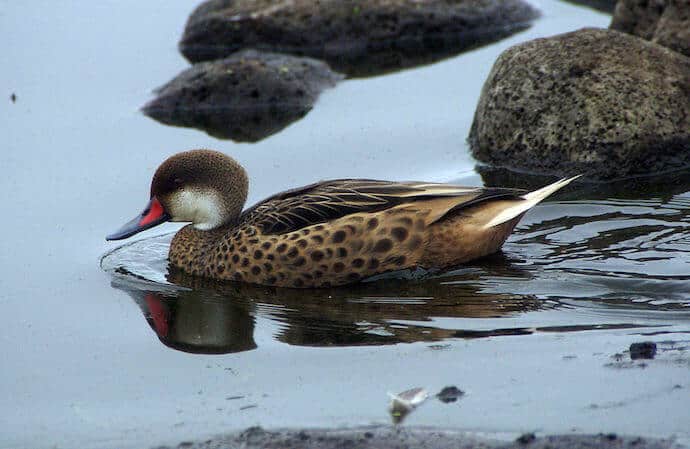
25. Galapagos White-Cheeked Pintail
Latin Name: Anas bahamensis
Habitat: Brackish lakes, estuaries, mangrove swamps
Size: Length: 13.4 in; Weight: 1.04 to 1.16 pounds
Diet: aquatic plants and small creatures
Conservation Status: Least Concern, population decreasing
This is one of several subspecies of White-cheeked Pintail, which is also known as the “Bahama pintail” or “summer duck.” It is what’s known as a dabbling duck, meaning that it usually feeds at the surface of the water rather than diving down.
Commonly known as the Galapagos Pintail, it’s related to the Lesser Bahama Pintail, which is found in the Caribbean Islands and south Florida; and the Greater Bahama Pintail, which breeds in Argentina and winters in northern South America.
They’re distinctively beautiful ducks unlike any other species you’ll find in their habitat. Both sexes essentially look the same, with brown spotted breasts, white cheeks and tail feathers, and a bright red base on their bill.
You’ll typically find them in saline waters, including brackish lakes, estuaries, and mangrove swamps. They nest on the ground near the water, hidden amongst the vegetation, emerging to feed on aquatic plants and insects. –Megan Butler & Bret Love; photos by Bret Love & Mary Gabbett unless otherwise noted
If you enjoyed our Galapagos Birds story, you might also like:
GALAPAGOS ISLANDS: San Cristobal & Genovesa
GALAPAGOS ISLANDS: Genovesa & Fernandina
GALAPAGOS ISLANDS: Isabela & Santiago
GALAPAGOS ISLANDS: North Seymour & Bartolome
GALAPAGOS ISLANDS: Santa Cruz & Espanola
Galapagos Islands Video: Sea Lions
